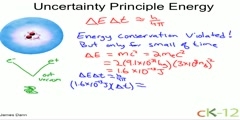Lec 15 - Uncertainty and the Rational Expectations Hypothesis
"Lec 15 - Uncertainty and the Rational Expectations Hypothesis" Financial Theory (ECON 251) According to the rational expectations hypothesis, traders know the probabilities of future events, and value uncertain future payoffs by discounting their expected value at the riskless rate of interest. Under this hypothesis the best predictor of a firm's valuation in the future is its stock price today. In one famous test of this hypothesis, it was found that detailed weather forecasts could not be used to improve on contemporaneous orange prices as a predictor of future orange prices, but that orange prices could improve contemporaneous weather forecasts. Under the rational expectations hypothesis you can infer more about the odds of corporate or sovereign bonds defaulting by looking at their prices than by reading about the financial condition of their issuers. 00:00 - Chapter 1. The Rational Expectations Hypothesis 12:18 - Chapter 2. Dependence on Prices in a Certain World 24:42 - Chapter 3. Implications of Uncertain Discount Rates and Hyperbolic Discounting 46:53 - Chapter 4. Uncertainties of Default On the other hand, when discount rates rather than payoffs are uncertain, today's one year rate grossly overestimates the long run annualized rate. If today's one year interest rate is 4%, and if the one year interest rate follows a geometric random walk, then the value today of one dollar in T years is described in the long run by the hyperbolic function 1/ √T, which is much larger than the exponential function 1/(1.04)T, no matter what the constant K. Hyperbolic discounting is the term used to describe the tendency of animals and humans to value the distant future much more than would be implied by (exponentially) discounting at a constant rate such as 4%. Hyperbolic discounting can justify expenses taken today to improve the environment in 500 years that could not be justified under exponential discounting. Complete course materials are available at the Open Yale Courses website: http://open.yale.edu/courses This course was recorded in Fall 2009.
Video is embedded from external source so embedding is not available.
Video is embedded from external source so download is not available.
Channels: Finance
Tags: Lec 15 - Uncertainty and the Rational Expectations Hypothesis
Uploaded by: yalefinancialth ( Send Message ) on 12-09-2012.
Duration: 76m 9s
Here is the next lecture for this course
Lec 25 - Suicide, Part II: Deciding under ...
50:16 | 2148 viewsLec 14 - Quantifying Uncertainty and Risk
01:04:10 | 2369 viewsHeisenberg Uncertainty
02:48 | 6804 viewsUncertainty principle energy physics
04:59 | 5903 viewsPrinciple of The Uncertainty Explained By ...
02:08 | 14211 viewsWhat is Heisenberg's Uncertainty Principle
07:30 | 8440 viewsThe Uncertainty Principle
03:52 | 5024 viewsHeisenberg Uncertainty Principle
05:48 | 6900 viewsWhat Are Rational Functions
04:19 | 4401 viewsDecimal Expressions Of Rational Numbers
04:35 | 3920 viewsWhat is Heisenberg Uncertainty Principle?
03:15 | 3111 viewsLec 79 - Rational Inequalities
11:49 | 2372 viewsLec 80 - Rational Inequalities 2
13:15 | 2073 viewsLec 28 -Attacking the God hypothesis in o ...
01:12:35 | 2136 viewsLec 12 - CA Algebra I: Rational Expressions 1
09:58 | 2256 viewsNo content is added to this lecture.
This video is a part of a lecture series from of Yale
Lecture list for this course
Lec 2- Utilities, Endowments, and Equilibrium
Lec 4- Efficiency, Assets, and Time
Lec 5- Present Value Prices and the Real Rate of Interest
Lec 6 - Irving Fisher's Impatience Theory of Interest
Lec 7 - Shakespeare's Merchant of Venice and Collateral, Present Value and the Vocabulary of Finance
Lec 8 - How a Long-Lived Institution Figures an Annual Budget. Yield
Lec 10 - Dynamic Present Value
Lec 12 - Overlapping Generations Models of the Economy
Lec 13 - Demography and Asset Pricing: Will the Stock Market Decline when the Baby Boomers Retire?
Lec 14 - Quantifying Uncertainty and Risk
Lec 16 - Backward Induction and Optimal Stopping Times
Lec 17 - Callable Bonds and the Mortgage Prepayment Option
Lec 18 - Modeling Mortgage Prepayments and Valuing Mortgages
Lec 19 - History of the Mortgage Market: A Personal Narrative
Lec 21 - Dynamic Hedging and Average Life
Lec 22 - Risk Aversion and the Capital Asset Pricing Theorem
Lec 23 - The Mutual Fund Theorem and Covariance Pricing Theorems
Lec 24 - Risk, Return, and Social Security
Lec 25 - The Leverage Cycle and the Subprime Mortgage Crisis
















